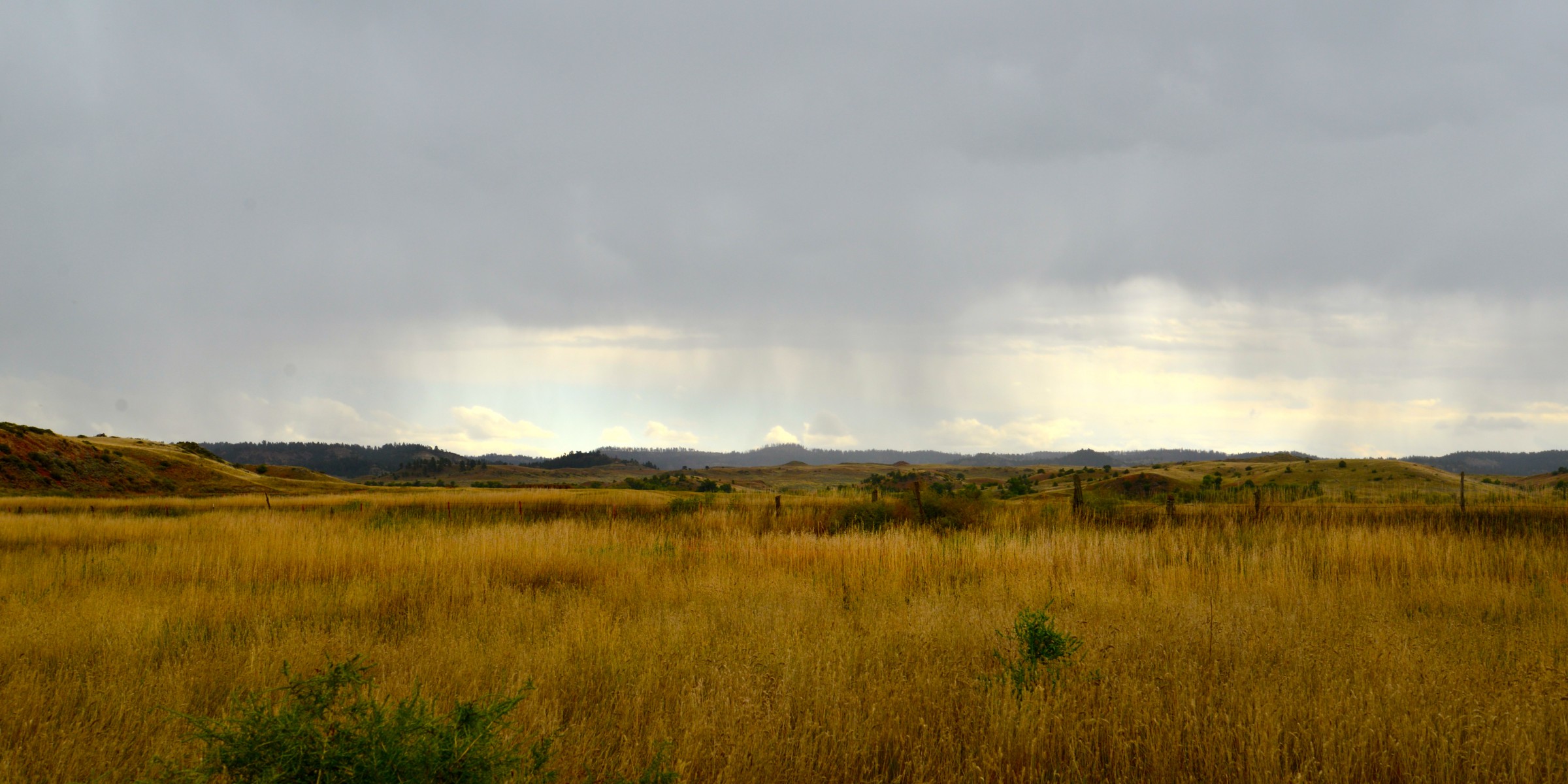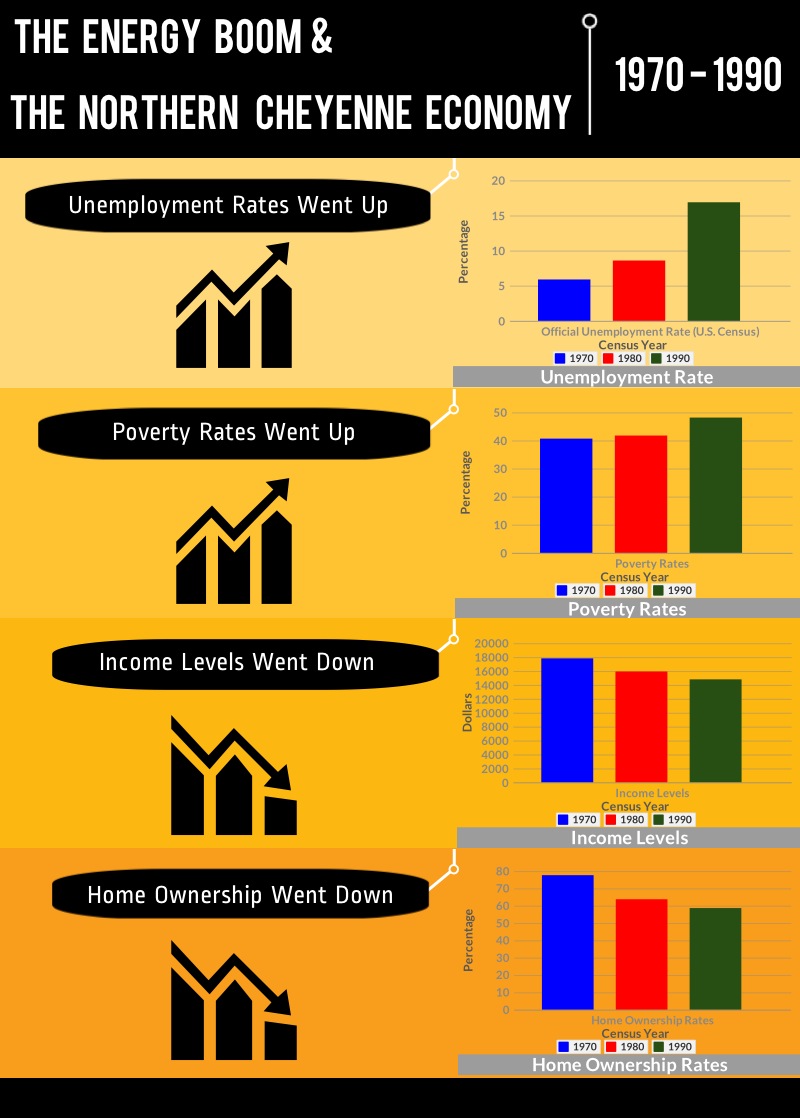What We Can Learn From The Energy Boom And Its Impacts On The Northern Cheyenne Economy

“But we all know how it goes. You guys move in, one side benefits and the other side doesn’t.” Northern Cheyenne tribal member, Otter Creek Scoping Hearing, February 2013
Back in the 1970’s and 1980’s, things were booming down in southeastern Montana. The Colstrip coal plant was under construction, coal mines were being dug, oil was being drilled.
But things weren’t booming for everyone. Yes, local, state and federal governments raked in tax revenues and royalties. Traveling workers were brought in for construction jobs. Money was filling the coffers of some of the biggest corporations in the country.
But that money never reached the Northern Cheyenne Tribe or its citizens. The truth is that despite the major energy development that was happening near the Northern Cheyenne Reservation, economic conditions got worse, both in absolute and relative terms. The mineral wealth created did NOT flow to the residents of the Northern Cheyenne Reservation.
This startling fact was the conclusion that economic and social researchers from the Northern Cheyenne Tribe and various universities found in their 2002 Report to the Bureau of Land Management.* [To download the relevant chapter of the report, please click on this link Northern Cheyenne Economic Study.] These researchers also believe they found the reason why the boom hurt instead of helped the economic, social and environmental conditions on the Reservation.
Why is what happened in the 70s and 80s relevant today? Because the circumstances that contributed to the decline in economic conditions on the Reservation during the boom have not changed and are not likely to change anytime soon.
Unfortunately, we can predict with a high level of certainty that if the Otter Creek Mine and Tongue River Railroad are built, it will hurt an already struggling Reservation economy.
During the Energy Boom Economic Conditions Deteriorated on the Reservation
In the report that I mentioned above, they explored the impacts of the energy boom on the Northern Cheyenne Reservation. What they found was startling.
- The unemployment rate tripled
- The poverty rate increased 10%
- Home ownership rates dropped 20%.
- Median Income levels fell 17% while income levels off the reservation doubled.
- Already stressed social services and economic resources on the reservation became even more strained.
Researchers found that these deteriorating economic conditions could be attributed directly to the boom. So, now the question is, why?
Why Didn’t the Tribe Benefit from the Boom?
The report stated four major reasons why the Tribe did not benefit from this boom and actually suffered from it, economically, socially and environmentally.
- The lack of access of Northern Cheyenne to highly paid energy jobs:
During the boom, tribal members were able to secure around 3-8% of the energy related jobs even though the tribal members were about 1/3 of the working age population in Rosebud County. This had nothing to do with educational levels. The education levels of Northern Cheyenne were almost equal to that of non-Indians in Rosebud County. Therefore, a majority of the positive impacts from the boom through wages completely bypassed the Reservation.
- The limited local commercial infrastructure on the Reservation:
If the workers in these energy jobs had spent their money on the Reservation, that would have benefited the local businesses and therefore benefited the local economy. However, workers took their paychecks and spent them in places like Colstrip or Billings. No money flowed to tribal businesses. The Reservation did not have a local economy in place to derive the benefits from that extra money. Colstrip and other urban economies like Billings expanded because of the new dollars. That expansion, in turn, took even more dollars away from the Reservation because Reservation residents also took advantage of the increased services and goods in Billings and other growing towns. Rather than gain from increased levels of income and expenditure, the Reservation economy shrunk.
- The Tribal government had no access to mineral revenue to support public services and infrastructure on the Reservation:
This is a big one. Rosebud County, the city of Colstrip, the state of Montana and the Federal Government were all beneficiaries of a significant amount of energy related revenues through mineral taxation and the sharing of royalty revenues. These governments could use those mineral revenues to expand the services provided to citizens and businesses, improve schools and other public facilities and finance various economic development and citizen support programs. The Northern Cheyenne Tribal Government did not have access to a share of those mineral revenues but had all of the same infrastructure, social and environmental impacts from the development. While other governments were able to use the money to improve their cities and towns the Northern Cheyenne could not do the same. Steps that the Tribal Government could have taken to increase the likelihood that some of the benefits associated with the energy boom would have reached their community could not be funded.
- The impact of the Northern Cheyenne commitment to place:
The report stated,
“To the Northern Cheyenne the Reservation is not just a convenient location temporarily chosen because of the economic opportunities in the area, but the Tribe’s permanent homeland. Tribal members over many generations have contributed substantial resources to the integrity and protection of their homeland. This commitment to place can be contrasted with the large, mobile, workforce that helped construct the coal mines, the Colstrip power plants and the oil fields. Those workers came for well-paid jobs that were available and when those jobs ended, they traveled on to other places in the pursuit of new economic opportunities. For the Northern Cheyenne, leaving the area is not usually an acceptable solution. The Northern Cheyenne are committed to making the Reservation a viable homeland for their people, economically as well as culturally, socially and environmentally.
The Economic Impacts of the Proposed Otter Creek Mine and Tongue River Railroad on the Northern Cheyenne Tribe: What has changed?
At the public scoping hearing held in Lame Deer in February of 2013, a young Northern Cheyenne man who had, for a short time, worked in a nearby coal mine, stated,
“But we all know how it goes. You guys move in, one side benefits and the other side doesn’t.”
What this young man said is exactly what happened in the 1970s and the 1980s to the Cheyenne people. The researchers state very clearly,
“Because Northern Cheyenne Reservation poverty is not so much a condition as a process or structural relationship between the Reservation and surrounding region, it tends to shape new development initiatives rather than being changed by them. This means that new development initiatives within the region, in the absence of conscious intervention, become part of this existing dynamic relationship and may tend to worsen rather than alleviate the poverty-stricken position of the Reservation.”
And now here we are at the brink of another massive energy development project to the east of the Northern Cheyenne Reservation.
And not one of those four conditions have changed since the first energy boom.
And not only has nothing changed, the money that the Northern Cheyenne were promised by the state of Montana in the 2002 Otter Creek Settlement Agreement to deal with impacts from this development have never been secured.
“Federal legislation will be sought which will: (a) provide federal funding to the Tribe for Reservation public services and facilities; (b) provide federal funding for certain Tribal cultural activities relating to Otter Creek and the surrounding area; and (c) rectify a claimed 100-year old federal error which deprived the Tribe of ownership of 8 ½ sections of Reservation subsurface.” (Exhibit C, Otter Creek Northern Cheyenne Settlement Agreement)
Guess how many of those have happened?
If you guessed zero, you guessed right.
And, as a side note, don’t you love that instead of the coal company paying for infrastructure and public service needs that will be created by their mine, taxpayers are expected to pick up the bill?
Learning From The Past
The coal companies and the state of Montana come to southeastern Montana with promises of economic development and prosperity. They say that this coal mine and the railroad will provide much needed jobs for Reservation residents. They say there will be employment programs but leave out that there will be no hiring preference or quotas and therefore no real way to hold the companies accountable. They say it will bring prosperity to a struggling rural economy.
But what they don’t tell you, what they don’t want people to know, is that it will hurt the people who are least equipped to deal with the impacts. It will hurt the already struggling economy on the Reservation. It will degrade water quality in the Tongue River, a river that people depend on for food and water. It will cause air pollution in Ashland, Lame Deer and Birney, causing increase in asthma, cancer, heart disease and other illnesses. It will bring in more drugs and social problems, causing a strain on the communities and social services.
And there will be no one there to pick up the pieces because Arch Coal is just there to open a coal mine, and nothing else.
Please send me a message if you would like the entire report by the Northern Cheyenne Tribe to the BLM and state of Montana. It is an extremely large file. However, you can download Chapter 3, detailing the impacts of the boom on the Northern Cheyenne Tribe by clicking here.
* To download a list of the report’s authors and researchers, please click here.


Pingback: State of Montana deems Arch Coal’s Otter Creek air quality permit application incomplete; Northern Cheyenne Class I Airshed ignored | east of billings